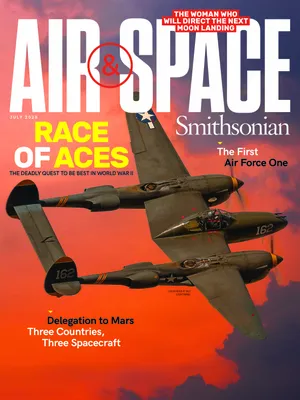This Rare Replica Warbird Is Made From Pizza Pans and Lawnmower Parts
A Nakajima Ki-43 Hayabusa could be the first homebuilt to be built of actual pieces of a home.
/https://tf-cmsv2-smithsonianmag-media.s3.amazonaws.com/filer/6a/10/6a104422-889f-4c83-bb3c-57306a2ee508/07a_jj2020_zeb_creditpaulhannah_live.jpg)
Cruise Google Earth over the piney woods of North Carolina around the tiny community of Moncure, and if you’re lucky, you will fly over an astonishing sight: a silvery Japanese fighter, big red meatballs atop its wings, half hidden under trees in a ramshackle backyard. If you’re really sharp, you might recognize it as a Nakajima Ki-43 Hayabusa, code-named Oscar. The Oscar was often called “the army Zero,” and a very effective World War II fighter it was.
But how did this one get to rural North Carolina, since only about a half dozen Oscars are known to exist, all in museums or under restoration?
You’ll have to ask Zeb Harrington, who in fact is building the backwoods version. Building it out of welded electrical tubing, pizza pans, kitchen mixing bowls, Ball jar lids, lawnmower parts, pork-and-bean cans and “pieces of my mama’s roof,” Harrington explains in a raspy Carolina accent thick enough to bottle as barbecue sauce.
“Most of my parts come from Lowe’s,” he says. “I framed the plane with welded light metal conduit. My mother’s house several years ago had a new roof put on it, and I used the tin from the old one to cover the plane.” Harrington’s Oscar even has a convincing cockpit. “I got pictures of the real cockpit, and I made it just as close as I could. I found a way to use tin cans as housings for the phony gauges, and I use stamps to put the numbers on them. You pick up a lot of stuff as you go along—how to do things.”
Harrington has indeed had time to practice. His first life-size replica, built in 2012, was a Curtiss P-40N, which now sits in shambles, a broken-down exhibit at the local airport. “I wanted to cover it and keep everybody off, but the kids got on it,” he says. “Stuff happened. I’m done finished with that.”
His next project was a Messerschmitt Bf 109E, which he completed in 2017 and used as a personal dream machine. “I’d fly over the [English] Channel when I was here by myself. I flew it over the Channel many times. It’s a whole lot safer to do it in that thing.”
Harrington comes by his fascination with airplanes thanks to a 30-year career in the U.S. Army, the Reserve, and the National Guard, much of it as a paratrooper. “I just got military on my mind,” he says. “I worked on planes, I rode in planes. I was also in a Nike Ajax unit, surface-to-air missiles to shoot down planes. So I’ve done the whole circle on that.
“I’ve flown in some light airplanes, but I like the big planes, like the C-130 and -141 and -123, Caribous. I jumped out of C-119 Flying Boxcars back in the sixties. I had jump status for 20 years and done over 100 jumps. Keeps your mind busy.”
Has he ever thought about learning to fly himself? “I thought about it, I laughed about it, and I forgot about it,” he says. “I’m too old to care about it now. I’ll be 82 next month.”
Harrington has been fabricating things all his life, beginning with homemade airplane and train models when he was a boy. “When I got out of the Army, I farmed a little bit with my daddy,” he says. “Farming, you’re always fixing stuff, so I taught myself how to weld. And then I got into construction and picked up other skills. I’m a pack rat, so if somebody on a building project was throwing something away, I’d drag it home. My backyard looks like Fred Sanford’s junkyard.”
Harrington bases his replica airplanes not on plans but on photos and drawings. For no good reason, he builds them not full size but to 91-percent scale: For every foot of the real article’s dimensions, he subtracts one inch. “I don’t know why—it was just something to do. Don’t ask me to explain it,” he laughs. “A lot of this stuff I built in my mind way ’fore I build it physically. I sit and think about it well before I get into it. I don’t know whether that’s a gift or a curse. Right now, I’m working on a Vickers Type 89 machine gun that goes in the Oscar. Whatever comes to mind. You’ve got to stick to it, you know, or the mind gets rusty.”
Harrington figures that his replicas each cost about $2,500 to build. “But that runs over three years, so it’s really not that much.” If I offered him $10,000 to build me a P-51, would he do it? “Probably not. I’m doing it just for my entertainment. I don’t want the money, it’s just the satisfaction of doing it. It’s my creation, and I did it.”
